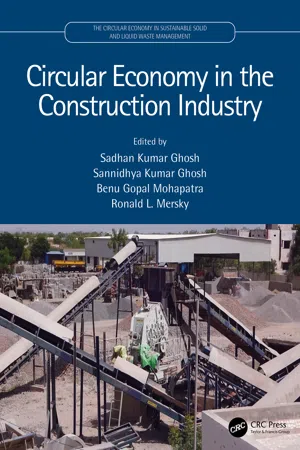
Circular Economy in the Construction Industry
Sadhan Kumar Ghosh, Sannidhya Kumar Ghosh, Benu Gopal Mohapatra, Ronald L. Mersky, Sadhan Kumar Ghosh, Sannidhya Kumar Ghosh, Benu Gopal Mohapatra, Ronald L. Mersky
- 238 pagine
- English
- ePUB (disponibile sull'app)
- Disponibile su iOS e Android
Circular Economy in the Construction Industry
Sadhan Kumar Ghosh, Sannidhya Kumar Ghosh, Benu Gopal Mohapatra, Ronald L. Mersky, Sadhan Kumar Ghosh, Sannidhya Kumar Ghosh, Benu Gopal Mohapatra, Ronald L. Mersky
Informazioni sul libro
Circular Economy in the Construction Industry is an invaluable resource for researchers, policymakers, implementers and PhD and Masters-level students in universities analyzing the present status of Construction and Demolition Wastes (C&DW) management, materials development utilizing slag, fly ash, HDPE fibre, geo-wastes, and other wastes, green concrete, soil stabilization, resource circulation in construction sectors, success in experimentation & commercial production, future needs, and future research areas. While huge C&DW is wasted by dumping, there is potential of recycling preventing greenhouse gas (GHG) emissions and environmental pollution as well as creating business opportunities. Circularity of resources in the construction industry can contribute to a more secure, sustainable, and economically sound future through proper policy instruments, management systems, and recycling by selecting the following:
- Supply chain sustainability and collection of C&D Wastes,
- Appropriate separation and recycling technology,
- Enforcement of policy instruments,
- Productivity, quality control of recycled products and intended end use,
- Economic feasibility as business case, commercialization, generating employment.
This book addresses most of the above issues in a lucid manner by experts in the field from different countries, which are helpful for the related stakeholders, edited by experts in the field.
Domande frequenti
Informazioni
Part I Sustainable Construction Practices and Circular Economy
1 Circular Economy in Combating Construction and Demolition Wastes Including Seismic Debris
- 1.1 Introduction
- 1.2 Construction and Demolition Waste (C&D) Generation Including Disasters Debris
- 1.3 Management and Recycling
- 1.4 C&DW Legislation
- 1.5 Discussion, Analysis, and Conclusion
- Acknowledgement
- References
1.1 Introduction
1.2 Construction and Demolition Waste (C&D) Generation Including Disasters Debris
Indice dei contenuti
- Cover
- Half Title
- Series Page
- Title Page
- Copyright Page
- Contents
- Foreword
- Preface
- Acknowledgements
- Editors
- Contributors
- Part I Sustainable Construction Practices and Circular Economy
- Part II Waste Utilization and Soil Stabilization
- Part III Sustainable Green Concrete
- Part IV Energy Recovery and Resource Circulation in Construction
- Index